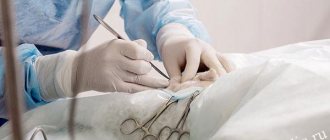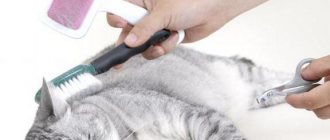What is sterilization
The instinct to procreate is present in all animals. Domestic cats are no exception. If the owner has decided not to breed kittens, then sterilization is considered the optimal solution.
The fact is that puberty occurs early in cats. Before reaching one year of age, the pet begins to persistently demand “dates”. If there is no pair within reach, the animal repeats the “search” quite often. Some cats "walk" several times a year. And there are those who go in search of their chosen one every month.
In addition to the moral issue - and it lies in the patience of the owner to withstand the cat's "songs" - there is also the issue of health.
Suppressing the natural instinct of the reproductive system has a negative effect on the animal’s body. In addition to the exhaustion that a cat regularly experiences during heat, there is a real threat to health.
That is why it is not recommended to keep a cat in such a “suspended” state. If kittens are not wanted in your home, it is best to have your pet neutered. This is a fairly simple procedure and does not harm the body, unlike the monthly unsuccessful attempts of a cat to find a mate.
Some owners prefer to “treat” estrus with hormonal drugs, however, this method gives a temporary effect. Moreover, with the constant use of such tablets, the risk of developing diseases of the reproductive system increases sharply.
Unlike the “hormonal” method, the operation has virtually no contraindications and is performed without complications. And the rehabilitation of an animal after such an intervention depends to a greater extent on subsequent care rather than on the actions of the doctor during the procedure.
How to prepare a cat for sterilization
Sterilization of a cat is a abdominal operation, a surgical procedure performed under general anesthesia. To minimize possible complications and reduce stress levels, it is necessary to prepare your cat for surgery.
Preparation for surgery:
- Preoperative examination by a veterinarian and preliminary consultation. You need to make sure that the animal is absolutely healthy and there are no contraindications to surgery. Your doctor may order a urine and stool test. During the period of estrus, the cat is not sterilized.
- Studying the vaccination card. If your cat has never been vaccinated, or was vaccinated more than a year ago, then vaccination should be done 3-4 weeks before surgery. In the postoperative period, the cat’s body is very susceptible to infections and viruses.
- Antiparasitic treatment. 20 days before the proposed operation, the cat needs to be removed from fleas and worms (this is especially important for cats that are outdoors).
- Manicure. The cat's claws need to be trimmed to prevent the animal from scratching itself during the healing period of the postoperative wound.
- Additional examinations. If your middle-aged or older pet is predisposed to health problems due to the characteristics of the breed (British and Scottish cats), then it is quite possible to prescribe additional examination methods (taking blood for analysis, performing an ultrasound or ECG).
- Anti-stress preparation. If your cat is particularly nervous and excitable, your doctor may prescribe sedatives a few days before surgery. These drugs are given only as prescribed by a veterinarian.
- Starvation diet. On the eve of the operation, you need to stop feeding the animal 12-18 hours before surgery, and stop giving water 5-7 hours before. Anesthesia on a full stomach causes a gag reflex, and this is dangerous before, during and after surgery.
Castration and sterilization
When discussing the nuances of the operation, the concepts of “castration” and “sterilization” are often interchangeable and used as synonyms. However, in medical terminology, these concepts have radically different meanings. What is the difference between these procedures?
It is important to note that castration and sterilization do not have a “gender specificity.” Both males and females are subject to both procedures.
Sterilization
Sterilization is a surgical intervention during which certain areas of the reproductive system are ligated. In females, the fallopian tubes are “tightened.” At the same time, the animal’s sexual function is completely preserved—the reproductive system operates as usual. The only difference is that mating does not end with pregnancy.
Castration
Castration implies a surgical intervention, as a result of which part of the reproductive organs of the animal is removed. Cats have their ovaries removed (sometimes with the uterus), and male cats have their testicles removed. As a result of castration, the animal's reproductive instinct fades away.
Both methods have their pros and cons. It does not provide a 100% guarantee that the cat’s health will always be excellent. This operation turns the reproductive system into a slow-moving mechanism that can fail at any moment. Therefore, most veterinarians advise giving preference to castration as a more reliable method.
Types of sterilization of cats: the difference between sterilization and castration
Sterilization (oophorectomy) means removal of the ovaries, and castration (avariohysterectomy) means removal of the ovaries along with the uterus. The result of sterilization is the cessation of the production of sex hormones and, as a consequence, estrus. It is indicated for young nulliparous cats with a healthy uterus. The disadvantage is the possibility of purulent processes occurring in the uterus. After castration, the risk of health problems, and in particular with the uterus, is reduced to zero. The procedure is performed at any age.
There is also tubal occlusion, a method in which the fallopian tubes are tied. The method does not justify itself, because the possibility of pregnancy is excluded, but periods of estrus with characteristic behavior remain.
When to sterilize
Sterilization is a simple operation, however, it has certain indications for implementation. In most cases, young cats are spayed.
There are a number of nuances that need to be taken into account if you decide to subject your cat to surgery:
- The cat must reach sexual maturity. The onset of this moment depends on the breed and health status of the animal, so only a veterinarian can determine whether the pet is ripe.
- Some veterinarians advise carrying out the procedure even before the onset of the first heat.
- If there is a heat, it is advised to wait until it ends, since surgery can cause bleeding. It is best if at least a week passes after the end of the “mating season”.
- Only completely healthy animals are allowed to be sterilized. Therefore, examination before the procedure is mandatory. It is also worth noting that sterilization of pregnant and lactating cats, although possible, is highly undesirable.
It is not advisable to sterilize pregnant or lactating women.
Despite the fact that it is best to castrate young animals, there is a danger of developmental disorders if the kitten was too small at the time of the operation. Such interference in the body can cause not only physical developmental defects, but also “mental” abnormalities.
Most veterinarians are inclined to believe that it is optimal to remove reproductive organs between the ages of 7 and 10 months.
Sterilization of older animals has its own nuances. The older the cat, the more undesirable it is to expose its body to such a load. Even if the procedure is successfully performed, the likelihood of developing breast cancer increases significantly!
Why is sterilization usually necessary?
- Almost monthly estrus lasting from three days to two weeks (depending on the breed and individual characteristics of the female) not only leads the cat to nervous exhaustion over time, but is also fraught with the occurrence of many genitourinary diseases, for example, endometriosis.
- Cats behave too actively, sometimes even aggressively, make loud noises, irritate and disturb all family members.
- If you don’t keep an eye on the female, she can bear offspring two or even three times a year. A number of additional problems arise - pregnancy, care, placement of kittens.
- An unsterilized animal that has not been bred often suffers from pyometry (a purulent inflammatory process in the uterus).
Also read the article about castration of cats.
Motherhood
There is a misconception that a cat must give birth before being spayed. This is a myth and has no basis in argument. The cat has only instincts, so she does not feel the desire to become a mother.
The cat does not strive for motherhood
Having allowed a cat to reproduce once, subsequent sterilization may simply not be effective. Even after the operation, Murka will exhibit sexual instincts. And a state of stress can lead to even more serious consequences - a false pregnancy.
Preparing for surgery
So, the animal has been examined, it’s time to prepare for surgery.
In order to choose a suitable day, you need to focus on the owner’s schedule. For two days after the operation, the cat should be under the supervision of a person who can provide assistance to her if necessary.
It is strongly recommended not to feed the animal before the procedure. It is best to fast your pet for 10-12 hours before the start of the process. During “unloading” it is also necessary to ensure emptying of the digestive tract. In this case, the cat is given a small amount - 1 tsp - of Vaseline oil.
Also, during a hunger strike, the cat must have access to water. Three hours before the start of the operation, the water must also be removed. It is also worth taking care that the cat does not find liquid in other places: remove vases, water for indoor plants and close the aquarium.
Advice on “unloading” must not be violated! Failure to comply with this rule may provoke a gag reflex in an animal under anesthesia. Also, feeding before surgery creates additional stress on the heart, which is already loaded to the limit under the influence of anesthesia.
Before sending to the clinic, you need to prepare everything you need. You will need:
- a carrier for transporting a pet to the hospital,
- a basket or box for returning home (the animal will still be under anesthesia, so a carrier will not be suitable for this purpose),
- a blanket that the cat will need to wear after the operation;
- litter for the box, sterile diaper;
- passports - owner and documents of the cat;
- care products - napkins, towel;
- You may need a heating pad if your doctor tells you to use it.
A blanket is a must for any surgical procedure. “Clothes” will not only protect the seams from dust and dirt, but will also prevent damage to the integrity of the seams when the animal begins to come to its senses and try to move.
Sterilization at home
The procedure for sterilization at home is no different from intervention in a veterinary clinic (except that the animal does not need to be transported after the manipulation; it will feel calmer in its familiar environment). The event takes place as follows:
- preliminary diagnostics: laboratory tests of urine and blood, ECG, ultrasound;
- preparatory measures: refusal of food for twelve hours, from water for three hours;
- administering general anesthesia to the pet;
- carrying out manipulations, suturing;
- a rehabilitation period that begins immediately after the animal emerges from anesthesia.
The owner needs to control that the cat does not lick the wound even through bandages, tampons, or a pompom.
After sterilization at home, the animal must be provided with warm conditions (while under anesthesia, the temperature decreases). You can cover your pet with a soft blanket, flannel cloth, or shawl.
The animal must be placed on a bedding on the floor. It can fall from a height and be injured. A diaper is placed under the cat: it is not yet able to control urination.
While under anesthesia and when recovering from it, the animal's eyes are open. Their mucous membrane begins to dry out, so it is recommended to use special moisturizing drops. They can be replaced with ordinary saline solution.
After anesthesia, the pet's coordination of movements is still impaired for some time. She may jump up, run and hit something. Therefore, it needs control.
To prevent the development of inflammation, the veterinarian often prescribes antibacterial drugs. Long-acting medications are usually used. Two injections may also be prescribed at an interval of two days. As a rule, it takes ten days for a cat to recover. At this time, you must follow all the doctor’s recommendations to avoid unpleasant consequences.
Anesthesia
Sterilization of cats involves surgery, which is performed under anesthesia. Before administering anesthesia, the doctor performs so-called premedication. What does this procedure mean:
- The animal is given drugs that reduce muscle tone;
- To avoid an allergic reaction, antihistamines are administered;
- The cat is also given substances that prevent excessive production of saliva and phlegm;
- If necessary, pressure stabilization is carried out. Drugs that increase vascular tone are also administered.
All drugs, including anesthesia itself, are administered either intramuscularly or intravenously. The method is determined by the veterinarian.
Intramuscular anesthesia is used more often because it is cheaper and easier to use. The disadvantage of this method can be considered the long awakening of the animal after this type of “sleep”.
Intravenous anesthesia is a more expensive method, however, it has more advantages. The method is more manageable. If necessary, the doctor adjusts the amount of the substance during surgery. After such anesthesia, cats wake up faster and recover more easily. The method has fewer side effects and complications.
Laparoscopy of cats
Laparoscopic sterilization of cats is a surgical operation that is performed under general anesthesia, but is minimally invasive, that is, one in which the area of intervention in the cat’s body is minimized.
How is laparoscopy performed?
The surgeon makes minimal incisions, usually not exceeding 1 cm, even if sterilization is carried out to remove not only the ovaries, but also the uterus.
Then a special instrument is inserted into the incisions - special tubes equipped with surgical devices for sterilization, a light source and a camera at the ends. Thus, the surgeon sees what is happening inside the incisions on a special monitor, which displays an enlarged image from the laparoscope camera.
Advantages of laparoscopy
Advantages of laparoscopy over conventional abdominal sterilization surgery:
- The operation is gentle and can be performed on cats from 6-7 months to 13-15 years;
- due to minimal surgical intervention, the risk of infectious postoperative complications is practically reduced to zero;
- minimal postoperative care for sutures (treatment 1-2 times) or complete absence thereof;
- the absence of a large incision minimizes the cat’s postoperative pain;
- a milder prophylactic course of antibiotics compared to the course after abdominal surgery;
- no need to wear a postoperative blanket;
- sutures are applied with special threads that dissolve on their own, or there is a special glue that is used to seal surgical punctures;
- the animal returns to its normal lifestyle as quickly as possible after surgery.
Video:
How to avoid consequences
- Do not try to save money on such an operation, as it is quite expensive compared to sterilizing a cat using the classical method. A high-quality laparoscopy cannot be cheap!
- Please check the doctor's qualifications first. The limited range of motion of the surgeon during such an operation, the decrease in the tactile sensitivity of the doctor’s hands - all this requires a highly qualified doctor who will perform the operation on your cat.
- Agree only to undergo surgery in a clinic setting. Some veterinarians may suggest doing the surgery at home. We should not forget that laparoscopic sterilization is, although gentle, with minimal intervention, still surgical, performed under general anesthesia.
- Do not agree to surgery without preparatory measures. If the veterinarian assures you that preparation for such an operation is not necessary, you can bring your cat in right now - run away from such a would-be doctor.
How is the operation performed?
The entire sterilization procedure consists of several parts:
- Examination of the animal;
- Administration of anesthesia;
- Carrying out the operation;
- Removing a cat from anesthesia;
- Rehabilitation.
The operation is performed only on completely healthy animals. If immediately before the procedure any abnormalities in the pet’s well-being are detected, the procedure is postponed until recovery.
The operation itself lasts from 30 minutes to an hour. First, antiseptic treatment is carried out. Next, surgical intervention opens access to the internal organs. Then follow the manipulations regarding the operation itself. After this, the doctor applies stitches.
Laparoscopy
In addition to the classical methods of removing genital organs from pets, there is a laparoscopic method. During such an operation, all the same manipulations are performed as during regular castration, but the surgeon does not act through a regular incision, but through a small hole made in the animal’s peritoneum. The incision is about 2 centimeters in length, so wound healing and the rehabilitation period are much easier.
Some owners call this method the “no blanket” method. However, it is not. Since a small seam is still present on the animal’s body, it is best to secure it after the procedure is completed.
Sterilization methods
The operation itself takes place using several methods - which option to use is determined only by the veterinarian, taking into account the type of sterilization, the capabilities of the clinic, the age and health of the animal.
Classical
This is the most common method, most often used by veterinarians around the world. An incision is made with a scalpel in the center of the abdomen (the hair in this area is first shaved off). The length of the incision is small - up to 3 cm. The abdomen is incised along the white line, and through this hole the uterus or ovaries, or both of these organs, are removed (depending on the type of operation).
Open vessels are stitched with a special suture thread (ligature), which stops the flow of blood. After removal of the genital organs, the peritoneum and skin are sutured by suturing (this suture can be either removable or self-absorbing, which does not require further removal).
The removable suture is removed 8-14 days after surgery. The advantages of this method are a small incision and a relatively short recovery period (up to 12 days).
Side cut
It differs from the classic one in the location of the incision: with this method, the incision is made in the side (up to 4 cm), and the muscles are separated in a blunt manner. This method is more convenient for removing the ovaries, since it is not always possible to completely remove the uterus through such an opening.
But this method is less traumatic in comparison with the classical method - if intradermal sutures are applied, then 24 hours after the operation the cat can be released into the wild.
Ultra-small incision (using a surgical hook)
The name of this method speaks for itself - the length of the incision does not exceed 1 cm. The incision is made on the tummy, the abdomen is dissected along the white line, and the surgeon inserts a special hook into the small incision. With it he grabs the ligament and removes the ovaries.
In this case, as in the classic case, the vessels are sutured using a ligature. The advantage of this procedure is that the incision is very small, which heals much faster and does not cause much discomfort to the cat. However, it is not always possible to remove the uterus completely in this way, so it is only effective for oophorectomy.
Did you know? Cats are much lazier creatures than dogs. On average, they spend 2/3 of their life sleeping and resting - this means that a nine-year-old cat will sleep 6 years of its life!
Laparoscopy
Removal of the genital organs with this method occurs using endoscopic modern technologies. 3-4 punctures of the skin and abdomen are made, and the uterus or ovaries are removed using an endoscopic device. It should be noted that this is a state-of-the-art sterilization method and is quite expensive.
It is not used everywhere - laparoscopy requires expensive equipment and appropriate personnel skills.
It should be noted that all of the listed surgical operations are performed using general anesthesia. Of all these methods, it is difficult to single out the most effective and optimal one that would be suitable for all cats.
Such a variety of sterilization methods proves that each cat requires an individual approach. It is taking into account the characteristics of the animal’s body that an experienced surgeon chooses the method that will be most effective and less painful for each individual pet.
Cat care
Regardless of which method of operation was chosen, castration or sterilization, the cat will be weakened after the operation. Such an animal requires constant care and special conditions of detention.
After transporting home, the cat must be placed in a pre-prepared place. This should be an area in the apartment where a weakened animal will feel safe. It is necessary to exclude drafts, as well as eliminate other pets. Children should also not have access to a sick pet.
It is best to place the cat on the floor, providing it with warm, sterile bedding. Murka cannot be placed on a sofa or other surfaces. When recovering from anesthesia, a cat may behave inappropriately and, without calculating its strength, fall from a height.
You should place a bowl of water next to your sleeping area. The cat may refuse food in the first days after surgery, but most likely not water.
For 7-10 days after sterilization, you need to provide the animal with maximum rest. Active games with children and other animals should be excluded. You should also move your cat less and try not to pick her up too much. Load on the sutures can compromise their integrity, so the impact on the wound should be minimal.
Wearing a blanket for the entire period of wound healing is mandatory!
Veterinarians most often use absorbable sutures, so no suture removal is required. Also, upon completion of the operation, antiseptic treatment of the wound is performed, after which care for the sutures is minimal.
Sterilizing a cat during pregnancy
Surgery during pregnancy and in the immediate period after the birth of kittens is also unfavorable for cats. Any period of hormonal changes or surges in the body can provoke complications. But there are also indications for this type of surgery. Extirpation of the pregnant uterus is carried out:
- At risk of cat death during childbirth. This situation occurs when the pet has heart or kidney failure due to chronic diseases. It is possible to develop severe complications - preeclampsia and eclampsia. These conditions are characterized by a critical increase in blood pressure, the final stage of which is convulsive syndrome, coma and death. The pathology can be eliminated only by removing the offspring by cesarean section, but in some cases, complete removal of the uterus is performed.
- In case of intrauterine death of offspring. This is an indication for emergency delivery. If the death of the kittens occurred long enough, rotting occurs, which also affects the uterine tissue. In this case, the uterus is removed along with the kittens. The operation is also indicated for purulent complications of pregnancy.
Also read the article about spaying cats during pregnancy and the reasons for and against it.
If surgery is necessary, you must definitely consult a veterinarian and, if he does not find other contraindications, the intervention can be carried out strictly no later than four weeks after conception or in the case of the indications listed above.
The cat owner must understand that in this case the animal’s recovery will take more than two weeks. Complications are possible, for example, from the cardiovascular system, there is a high risk of bleeding, as well as bacterial infections in the postoperative period.
We also recommend reading the article about sterilizing a cat after giving birth.
Nutrition
The doctor will tell you how long after surgery you can feed your cat. The period depends on the type of anesthesia used. Some medications allow eating as early as six hours after the procedure. Some anesthesia requires a 12-hour fast. It all depends on whether the drug affects the swallowing reflex.
If the cat was wearing a special collar, it is necessary to use a bowl smaller than the diameter of the device for feeding. It is best to place the bowl on a slight elevation to make it easier for your pet to reach the food.
If your pet shows an appetite, you can start feeding him. At first, you need to give food in small portions, after crushing it and soaking it in water. Preference should be given to attractive foods, as well as those lines that have a higher calorie content, so that a weakened animal receives maximum energy from a small amount of food.
Temperament features: before and after
There is an opinion that cats change after sterilization. This is a common misconception.
If the operation was carried out correctly and no complications arose during it, the animal’s temperament will not suffer. The procedure concerns only the reproductive function, which fades away after completion. As for the rest of the instincts, everything remains the same. The hunting skills and character traits of the pet will not tolerate changes.
Particular attention should be paid to the animal’s diet. After a change in hormonal levels, and this will inevitably happen, the cat may exhibit excessive appetite, which without proper control can lead to excess weight gain. Obesity in cats is a fairly common problem, so the menu for a sterilized cat is best composed of specialized food lines.
Also, to prevent excess weight, it is necessary to encourage the cat to play actively and have an active lifestyle.
Pros and cons of the operation
Sterilization has both positive and negative sides. There is no consensus on whether a cat should be sterilized.
Advantages
- The cat stops the nightly “songs” and squeaks of the gentleman. Not only the whole family sleeps peacefully, but also the animal itself;
- The question of placing kittens in good hands disappears. No more thinking about where to put the kids;
- The unpleasant odor in the house is eliminated, since sterilized animals do not mark the territory;
- Some cats show a decrease in aggression. Murka becomes affectionate and playful, which is good news;
- Even a pet that has access to walks will spend more time with the family. The search for the chosen one is replaced by home gatherings on the sofa;
- The risk of diseases associated with the reproductive system, as well as diseases of the excretory system, is significantly reduced. Neutered cats are less susceptible to developing mammary cancer.
Flaws
- Cats that have been neutered are often overweight. Not every owner is able to control the amount of calories consumed, so often the pet becomes like a ball in a very short time;
- There is no precise definition of when is the best time to have surgery. On the one hand, early castration will save both the animal and the owner from a number of problems. On the other hand, early sterilization is fraught with deviations in the development of the animal;
- There is a risk of complications. Even the simplest interventions sometimes end in peritonitis, inflammation or hernia. Also, violation of the integrity of the sutures is fraught with bleeding. Therefore, it is possible that after the procedure, the help of a veterinarian may still be needed;
- It happens that sterilization does not give the desired effect and the cat continues to look for love.
First of all, it is worth remembering that the issue of sterilization is more rhetorical. A person is not given the opportunity to know how an animal devoid of sexual instinct feels, so there is no definite answer to the question.
Sterilization makes changes to the animal's body, so the owner needs to consider the responsibility that falls on him when making such a decision.
Consequences and complications
Like any surgical intervention on the body, sterilization has its complications and consequences. This is due to the fact that each organism is individual and the reaction to surgery and after it can be unpredictable. To minimize risks, you must strictly adhere to all rules and regulations.
Vomit
Sometimes it is a consequence of the administration of anesthesia, even if all the rules of preparation for the sterilization operation are followed. If the vomiting is weak, then you just need to make sure that the animal does not choke in its own vomit. You should turn your head to the side to prevent vomit from entering your respiratory tract. If vomiting is severe or uncontrollable, you should immediately seek veterinary help.
Temperature
Lack of appetite, elevated body temperature, weakness, drowsiness. This condition is, in principle, normal, especially in the first hours after surgery and for 2 days after, but no more. If you have an elevated temperature (above 39°C) for more than 1-2 days after surgery, you should immediately consult a doctor.
A drop in temperature below 37°, and if warming the pet with heating pads does not help, this is an alarming symptom, in which you also need to seek medical help.
Internal bleeding
This will be evidenced by the lethargy of the animal, the pet is constantly lying down, attempts to touch or stroke it cause pain, if you open your mouth and look at the mucous membrane it will be very pale, almost white - consult a doctor URGENTLY!
Wound infection
The presence of redness, swelling (swelling), increased discharge from the wound, if the discharge becomes purulent in nature - all this also requires immediate intervention by a veterinarian. The presence of slight redness and slight swelling or swelling is acceptable for the first 3-4 days after surgery, but no more.
Atypical behavior
Cats may exhibit behavior similar to being in heat. This is because the ovary may not be completely removed and the remaining parts of the ovary produce hormones that cause this behavior. You should seek advice from your veterinarian, preferably the doctor who performed the surgery.
Obesity
Do not forget that the use of anesthesia and hormonal imbalance slow down the metabolism. To prevent the appearance of excess weight, after the sutures have been successfully removed and the postoperative wound has healed, provide the cat with the necessary daily physical activity. Take care to create a balanced diet. Don't overfeed your pet!
Be a caring and attentive owner and if you have any suspicious symptoms, do not neglect to contact your veterinarian.
How much does the operation cost?
The cost of the operation depends on many factors. The price question is formed taking into account the following factors:
- The doctor’s experience and the prestige of the clinic. You should not trust your pet to an inexperienced veterinarian. It is best to turn to specialists who can boast of positive reviews;
- Method of carrying out the operation;
- Type of anesthesia and cost of drugs;
- The area where the event will take place. Some doctors practice castration at home. This saves owners from having to transport the animal. However, this method cannot ensure complete safety in terms of hygiene.
The minimum cost of the operation is 2500 rubles. It must be remembered that cheapness will definitely affect the quality, so it is better not to take risks and not use the services of doctors who offer low prices.
If you have any questions on the topic, ask them in the comments section.











